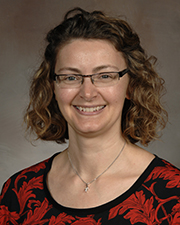
Pamela Wenzel, PhD
- Associate Professor, Department of Integrative Biology and Pharmacology, McGovern Medical School
- IMM-Center for Translational Cancer Research
Biography
Research
Stem cell potential is tightly linked to the biophysical cues present in the microenvironment. Members of our lab study how extrinsic mechanical cues, such as the frictional force caused by blood flow or the topographical features of the niche, impact self-renewal, fate selection, cellular function, and development.
Lab Members
Hyun Lee | Abishek Vaidya | Alex Alexander | Katherine Price | Joyce Ozuna
Training
Dr. Wenzel began her training as a stem cell biologist at The Ohio State University with Dr. Gustavo Leone. Her doctoral studies there focused on the developmental defects caused by genetic mutations of two classes of genes renowned for their relevance to cancer, Rb and E2f. She identified a critical role for Rb in regulating proliferation and differentiation of trophoblast stem cells by generating Rb-deficient trophoblast (placental) stem cell lines and a placenta-specific Cre-expressing transgenic mouse, referred to as CYP19-Cre. With these genetic tools, she showed that ablation of Rb in the stem cell compartment of the placenta was sufficient to cause death of otherwise normal fetuses and that the lethal placental phenotype resulting from loss of Rb induced non-cell autonomous defects in fetal tissues such as the central nervous system and red blood cells.
In parallel, she developed complementary systems to address the requirement for the E2f1, E2f2, and E2f3 transcription factors, the primary mediators of Rb transcriptional regulation, in initiation of the cell cycle. Using genetic ablation in mice and derivation of embryonic and trophoblast stem cell lines triply-deficient for E2f1-3 she demonstrated that, in stark contrast to dogma established by fibroblast-based assays, E2F activators are not required for cell cycle progression. In fact, expression of cell cycle regulatory genes modulated by E2F activators were upregulated in triply-deficient cells and embryos, suggesting that E2F activators possess repressor-type functions in vivo.
Dr. Wenzel moved to Children’s Hospital Boston and Harvard Medical School to complete her post-doctoral training, mentored by a true pioneer in the field of stem cell biology and reprogramming, Dr. George Q. Daley. There she focused on hematopoietic stem cell biology. She studied a number of extrinsic factors, including biomechanical force, soluble molecules, and pharmacological compounds that endow hematopoietic precursors with the ability to contribute to the adult blood system. Conversely, she also studied the inhibitory role that adipocytes play in hematopoiesis of the adult bone marrow and showed that expansion of fatty marrow interferes with recovery of hematopoietic progenitors following radiation therapy in animal models.
Publications
- Wenzel, P.L.*, Wu, L.*, de Bruin, A., Chong, J.L., Chen, W.Y., Dureska, G., Sites, E., Pan, T., Sharma, A., Huang, K., Ridgway, R., Mosaliganti, K., Sharp, R., Machiraju, R., Saltz, J., Yamamoto, H., Cross, J.C., Robinson, M.L., and Leone, G. 2007. Rb is critical in a mammalian tissue stem cell population. Genes Dev 21(1): 85-97. PMCID 1759903. * Equal contribution.
- Wenzel, P.L. and Leone, G. 2007. Expression of Cre recombinase in early diploid trophoblast cells of the mouse placenta. Genesis 45(3): 129-134.
- Chen, D., Pacal, M., Wenzel, P., Knoepfler, P.S., Eisenman, R., Leone, G., and Bremner, R. 2009. Division and apoptosis of E2F-deficient retinal progenitors. Nature 462: 925-929. PMCID 2813224.
- Chong, J.-L.*, Wenzel, P.L.*, Saénz-Robles, M.T.*, Nair, V., Ferrey, A., Hagan, J.P., Gomez, Y.M., Sharma, N., Chen, H.-Z., Ouseph, M., Wang, S.-H., Trikha, P., Culp, B., Mezache, L., Winton, D.J., Sansom, O.J., Chen, D., Bremner, R., Cantalupo, P.G., Robinson, M.L., Pipas, J.M. and Leone, G. 2009. E2F1-3 switch from activators in progenitor cells to repressors in differentiating cells. Nature 462: 930-934. PMCID 2806193. * Equal contribution.
- Adamo, L.*, Naveiras, O.*, Wenzel, P.L., McKinney-Freeman, S., Mack, P.J., Gracia-Sancho, J., Suchy-Dicey, A., Yoshimoto, M., Lensch, M.W., Yoder, M.C., García-Cardeña, G., and Daley, G.Q. 2009. Biomechanical forces promote embryonic haematopoiesis. Nature 459: 1131-1135. PMCID 2782763. * Equal contribution.
- Naveiras, O., Nardi, V.*, Wenzel, P.L.*, Hauschka, P.V., Fahey, F., and Daley, G.Q. 2009. Bone marrow adipocytes as negative regulators of the hematopoietic microenvironment. Nature 460: 259-263. PMCID 2831539. * Equal contribution.
- Wenzel, P.L.*, Chong, J.L.*, Saénz-Robles, M.T., Ferrey, A., Hagan, J.P., Gomez, Y.M., Rajmohan, R., Sharma, N., Chen, H.Z., Pipas, J.M., Robinson, M.L., Leone, G. 2011. Cell proliferation in the absence of E2F1-3. Dev Biol 351: 35-45. * Equal contribution.
- Ouseph, M.M., Li, J., Chen, H.-Z., Pécot, T., Wenzel, P., Thompson, J.C., Comstock, G., Chokshi, V., Byrne, B., Forde, B., Chong, J.-L., Huang, K., Machiraju, R., de Bruin, A., Leone, G. 2012. Atypical E2F Repressors and Activators Coordinate Placental Development. Dev Cell 22:849-862.
- Gustafsson, K., Heffner, G., Wenzel, P.L., Curran, M., Grawe, J., McKinney-Freeman, S.L., Daley, G.Q., Welsh, M. 2013. The Src homology 2 protein Shb promotes cell cycle progression in murine hematopoietic stem cells by regulation of focal adhesion kinase activity. Exp Cell Res: 319: 1852-1864.
- Lee, H.J., Li, N., Evans, S.E., Diaz, M.F., Wenzel, P.L. 2013. Biomechanical force in blood development: extrinsic physical cues drive pro-hematopoietic signaling. Differentiation: 86: 92-103.
- Arora, N., Wenzel, P.L., Ross, S., Chou, S., McKinney-Freeman, S.L., Yoshimoto, M., Yoder, M.C., Daley, G.Q. 2014. Neonatal engraftment defines the most nascent embryonic HSCs. Dev Cell, 29: 621-628.